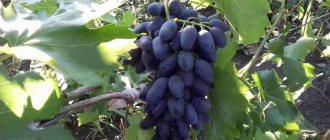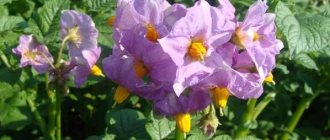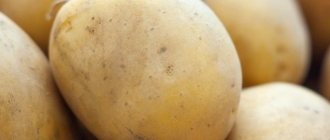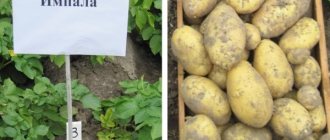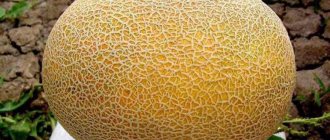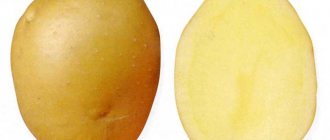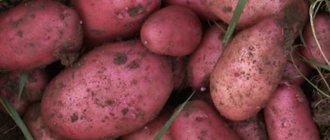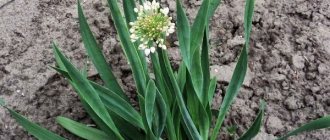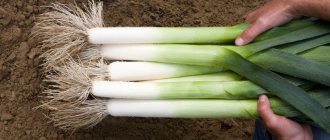Description of the variety
Purple potatoes have a delicate, nutty flavor and are distinguished by interesting tuber colors: from pale lilac to bright purple. It is especially valued for its beneficial properties and chemical composition.
Origin and development
The lilac-colored peel and pulp are not related to genetic engineering. Presumably colored potatoes originated in South America, then they became widely used in many countries around the world.
Reference! About 120 intermediate potato samples are involved in the development of breeders, which will make it possible to obtain new varieties and hybrids in the future.
Culture appeared in Russia relatively recently. Scientists are working to improve potato keeping quality and disease resistance.
Varieties of varieties
There are several varieties of purple potatoes of foreign and domestic selection. Some have an unusual color only on the skin, others are purple and purple inside.
Blue Danube
This mid-early variety of English selection is resistant to diseases, mechanical damage and drought. It has a dense peel of a lilac-violet hue. The yield of Blue Danube potatoes is about 350 c/ha. The white pulp is tasty and does not become overcooked. Used for soups, salads and frying.
Gypsy
The variety is mid-early, does not tolerate drought well, is resistant to cancer, gray rot, and scab. The flesh is yellowish and tender. The tubers have thin skins, so it is recommended to dig them up by hand. Productivity is 200–250 c/ha, from 6 to 14 potatoes are produced in one bush.
All Blue
The name of the variety of this purple potato means “All Blue” in English. The tubers have an interesting color: the peel and the middle of the pulp are dark blue, and the top layer is light blue. If you cut a potato, a light ring is clearly visible on the cut. During heat treatment, the color of the pulp is preserved.
The oval tubers are large: some weigh up to 200 g. The harvest does not last long, about 3 months, and germinates quickly.
Lilac
Russian mid-season variety. Tubers are medium in size, yield is 150–180 kg per hundred square meters. The potato flesh is lilac with a slight almond flavor. Good for salads.
Miracle Man
The mid-season potato Chudesnik was created at the Ural Research Institute of Agriculture. The peel and pulp are violet-amethyst, the taste is more delicate than that of ordinary tubers. Vegetables are rich in vitamin C.
The culture is resistant to fungal diseases and unfavorable climatic conditions. Productivity is low: 100–180 c/ha.
Adirondack Blue
Mid-season potatoes of American selection. Productivity reaches 400 kg per hundred square meters of land. The crop is susceptible to scab and late blight. The harvest is poorly stored; already in the middle of winter it begins to germinate and becomes soft. The pulp is inky in color, does not boil well, is more suitable for frying.
Miami
A mid-early variety, resistant to late blight, suitable for growing in the Moscow region, Siberia, and the Urals. Productivity - 350–400 c/ha. The peel and pulp of large tubers (weigh up to 110 g) are blue-violet. Miami potatoes have a sweetish taste; the vegetable is suitable for mashing.
Vitelot (French truffle)
A late variety, the tubers produce small ones (no more than 10 cm in length). Under the bush, 6-8 vegetables are formed, weighing 60-75, less often - up to 100 g. Gardeners note low yields: even under favorable conditions, no more than 200 kg are harvested from 1 hectare of land.
Reference! Alexandre Dumas especially liked this variety.
Truffle potatoes have a pleasant nutty taste and have good shelf life due to their thick skin. It is considered a gourmet variety. The dark purple pulp contains a lot of anthocyanins and starch. Suitable for purees.
Purple Peruvian (Peruvian purple)
Medium-yielding and fairly late variety. The mass of the tuber is about 80 g; about 180 kg of potatoes are harvested from one hundred square meters of land. The pulp has a pronounced hazelnut flavor, so it is often added to salads, even raw. The vegetable is purple outside and inside.
Chemical composition
All purple potato varieties contain:
- anthocyanins;
- calcium and potassium;
- phenolic acids;
- vitamins B1, B2, B5, B6, A, C, E;
- carotenoids.
Tubers contain 12-13% starch, which is significantly lower than that of their white-yellow counterparts. Therefore, this unusual vegetable is classified as a dietary product.
Ripening period
Typically, 60–90 days pass from the appearance of the first shoots to full ripening. These values vary depending on the variety.
Productivity
Most varieties of purple potatoes have high yields: up to 400 kg per 1 hectare of land. The exceptions are the Lilac, Vitelot and Peruvian Violet varieties. Their yield does not exceed 200 kg per 1 hectare.
Disease resistance
Lilac-purple potatoes are less resistant to diseases and pests than regular potatoes.
Main diseases:
- late blight;
- scab;
- bacterial cancer;
- all types of rot.
Characteristics of tubers
Depending on the variety, the pulp is white, yellow or inky in color, and the peel is always colored and quite dense. The weight of oblong tubers varies from 60 to 150 g.
Climate requirements
Potatoes with colored pulp are not yet grown on an industrial scale in the CIS. However, summer residents who are ready to experiment are equally successful in cultivating this vegetable in all regions of Russia, except Siberia and the Far East: due to the harsh climate, the crop grows poorly. Some varieties (Miami, Chudesnik) are more resistant to adverse weather conditions.
Reviews
★★★★★
Valery, 48 years old. About 6-7 years ago I was in Europe, and there, while visiting relatives, I was treated to purple potatoes.
Honestly, I was surprised not only by the color, but also by the taste. So, I bought seeds there and started growing them at home. At first the harvest was very small, but then I started planting tubers and things started to progress. Now the wife surprises all household members and guests with unusual dishes. By the way, today, as it turns out, you can buy seeds in Russia. I have already tried 4 varieties - violette, explosion, salble and mother of pearl. I can say that each is good in its own way. ★★★★★
Natalia, 54 years old. My neighbor has been growing violet for 3 years now, I tried it too.
I followed all agrotechnical rules and, indeed, the yield was not bad. We just can’t figure out what specific variety it is, but it’s delicious, with an almond flavor. Maybe someone can tell me? ★★★★★
Maryana, 22 years old. My parents grow Violetta violet, so in winter I am provided with these potatoes.
I prepare zrazy, bake, boil. Yes, anything can be done, if only you have imagination and desire. But what I especially like is that my child, who a priori does not like potatoes, eats purple ones. ★★★★★
Sergey, 49 years old. My relatives sent me purple potatoes from the Krasnodar region.
I don’t know the name of the variety, but I want to tell you about it. There weren’t many potatoes, so I planted them by cutting them into 1-2 eyes. Yes, I sprouted for about 3 weeks. I planted it in the ground and poured ash into the hole. The rest of the time I fed it a little with minerals. What was especially surprising is that there is no need to fill it with water, there are fewer problems. The variety is easy to distinguish from the rest - it has dark spots on the tops. When I dug it up, I was really upset, I couldn’t see the tubers in the ground, I had to call my daughter for help. The harvest turned out to be good, and the tubers are very large. I didn’t expect such a result from just my eyes. The only difficulties are the Colorado attack. The beetle likes this potato more than other varieties. So I collected him almost every day, often poisoning him.
★★★★★
Irina, 37 years old. I bought Violette at an exhibition.
A little expensive, but I wanted something exotic. I planted it in the ground, and after about 20 days shoots appeared. The bushes were small, I thought there would be no harvest, but when I collected them, I was surprised. I calculated so, per hundred square meters it turned out to be about 140-160 kg. Not very much, but considering that I threw in one eye at a time, it turned out well. I liked the fact that the tubers were large, with only 1-2 small ones per bush. I immediately put it aside for the next planting. I always store it in a cellar with ventilation, because, as it is written, the variety does not like humidity. Hide
Add your review
Purple potatoes contain many nutrients, have a unique color, piquant taste, and are used for diabetes and certain diseases. It is not very demanding to grow and care for, but it has its contraindications. If you decide to plant it in your garden and eat it, be sure to take into account all the above facts.
0
0
Copy link
Advantages and disadvantages of the variety
The main advantages of purple potatoes are their nutritional value and rich composition. The main disadvantages are susceptibility to disease and poor shelf life.
Features of purple-colored potatoes:
- tubers and pulp of unusual color, nutty taste;
- the culture is more capricious in care and is stored worse;
- Potatoes remain colored even after heat treatment.
Beneficial features
Purple potatoes contain potassium, which contributes to the smooth functioning of the cardiovascular system. Anthocyanins and polyphenols have antioxidant activity and inhibit the aging of the body.
Ascorbic acid helps strengthen the immune system, vitamin E helps maintain water balance and beauty of the skin, and B vitamins strengthen the nervous system. Carotenoids are indispensable for the full functioning of the human endocrine system, calcium is important for the skeletal system.
Dietary fiber improves the functioning of the digestive system. Due to its low starch content, the vegetable is approved for feeding people with diabetes.
The secret of the usefulness of truffle potatoes
Americans first started talking about the benefits of purple potatoes 20 years ago. Then several universities immediately stated that it contains an abundance of flavonoids:
- carotenoids – red-orange pigments;
- anthocyanins - purple-violet and green dyes.
Based on a long-term examination of more than 100 thousand patients, American doctors came to the conclusion that vegetables colored with flavonoids stimulate many beneficial processes in the body:
- reduce the intensity of platelet aggregation - eliminate the likelihood of blood clots;
- improve the elasticity of blood vessels, normalize blood pressure;
- have a positive effect on the endocrine system;
- synthesize vitamin A.
Flavonoids are antioxidants. They absorb free radicals - active molecules that have lost an oxygen atom and act on the body like carbon monoxide. These substances are known for their anti-cancer effect and are great for improving immunity. It is flavonoids that are responsible for the integrity of the DNA structure.
Biologists have found that according to these characteristics, colored tubers are 2–3 times superior to ordinary ones. If 100 g of white potato pulp contains 100–200 mg of antioxidants, then blue or red pulp already contains 500–2000 mg.
Features of planting and growing
When cultivating this vegetable, it is recommended to take into account some nuances. The culture is demanding to care for and requires patience and certain skills.
Preparing for landing
Tubers begin to be prepared 1.5 months before planting. They are transferred from storage to a warmer place and laid out in one layer.
Important! The ideal temperature for tuber germination is +10…+12°C. To speed up the appearance of sprouts, the seeds are periodically sprayed with water.
When the sprouts reach 2 cm, the potatoes are brought out into the light so that the sprouts do not stretch too much.
Soil requirements
The yield and taste of vegetables depend on the composition of the soil. The most unsuitable soil for purple potatoes is loam, the most favorable is light and fertile, saturated with air. The vegetable does not tolerate drought well, but stagnation of water must also be avoided.
Before planting, the soil is dug up twice: in the fall, before the first frost, and in the spring, immediately before planting. If the soil is too hard, add river sand.
Dates, scheme and rules of planting
The vegetable is planted in the spring, when the soil warms up to +5...+7°C, since the plant does not tolerate late spring frosts.
Holes about 10 cm deep are made in the dug up soil, and wood ash is added for disinfection. The holes are made according to a 35x60 cm pattern to provide enough space for rooting and formation of bushes. Potatoes are planted in the prepared holes using one of the selected methods.
Features of cultivation
Growing purple potatoes is no different from cultivating regular varieties.
There are two planting methods:
- traditional eyed;
- seedling
With the eye method, the prepared seed material is buried in the holes, sprinkled with wood ash. The first shoots usually appear 10–14 days after planting.
In the second option, the seeds are sown at home for seedlings. After this, the finished sprouts are transferred to a permanent place. Replanting begins in May, when the soil warms up to +5...+7°C.
Nuances of care
To successfully cultivate purple potatoes and obtain a rich harvest, you need to feed the plants, water and weed in a timely manner.
Watering mode
Caring for plants involves constant monitoring of soil moisture. If there has been no precipitation for 10–15 days, the seedlings are watered with warm water. Irrigation is especially important during budding and after flowering. It is necessary to avoid stagnation of water in the soil.
When an earthen crust forms, it is thoroughly loosened.
Top dressing
Purple potato varieties require periodic feeding: during budding and after flowering. Organic and potassium fertilizers are used. Before planting, it is advisable to add humus at the rate of 0.5 kg per 1 m2.
Weeding and hilling
The first hilling is carried out after the appearance of friendly shoots. This will protect young bushes from return frosts and retain moisture. The procedure is repeated when the plants reach a height of 30–35 cm.
Weeding is carried out several times during the summer as needed.
Disease and pest control
Many varieties are resistant to major potato diseases, but precautions are never superfluous.
Attention! Before planting, the seeds are treated with a fungicide and treated with potassium permanganate. This will protect the plants from late blight and some pests.
It is important to change the planting location, alternating crops on the site with legumes and cruciferous vegetables.
For potato diseases, Bordeaux mixture, copper sulfate, Kuprikol, Kurzat R (preparations based on copper salts), Ditan M-45 (active ingredient - mancozeb), Shirlan, Thanos are used.
Colorado beetles and click beetles are the main enemies of the crop. They spoil the tops and appearance of tubers, reduce productivity and negatively affect the shelf life of vegetables. Pests are eliminated using insecticides.
Features of purple potatoes
Lilac and purple potato varieties have certain characteristics. They are associated not only with appearance, but also with taste, as well as with chemical composition. The main characteristics are described below.
Purple varieties are characterized by a refined aroma
Taste qualities of purple potatoes
The taste of lilac tubers is about the same as white or yellow ones. But the aroma has clearly noticeable nutty tones, which makes the dish more piquant. If you add coconut milk instead of regular milk, you get a real exotic side dish. These potatoes are suitable as a side dish for any meat and fish dishes.
Potato varieties with purple flesh inside are used to prepare all kinds of dishes:
- mashed potatoes, boiled potatoes;
- fried, fried;
- stewed;
- salad ingredient;
- chips.
Important! Purple potato varieties with blue flesh contain a lot of anthocyanins. These are useful substances that prevent the development of cancerous tumors. Therefore, doctors recommend including such products in the diet on an ongoing basis.
Advantages and disadvantages
Potatoes with lilac skin and pulp have quite a few advantages. Among the main advantages are the following:
- interesting appearance;
- unusual taste;
- suitable for preparing any dishes;
- contains many vitamins and minerals;
- has high immunity to diseases.
But there are also disadvantages:
- not all varieties of purple-skinned potatoes will take root in Russia, so the description needs to clarify in which regions they can be grown;
- the cost of planting material is much higher than traditional potato varieties;
- getting tubers for planting is not always easy;
- productivity is relatively low.
Harvest and storage
The conditions for collecting and storing purple potatoes largely depend on the varietal characteristics.
How and when to collect
Some varieties of tubers have quite thick skin; vegetables are harvested using special equipment or a walk-behind tractor:
- Witelot;
- Blue Danube;
- Peruvian purple.
It is better to dig up more tender tubers by hand with a shovel or pitchfork. These varieties include:
- All Blue;
- Gypsy;
- Lilac;
- Adirondack Blue;
- Miracle Man;
- Miami.
Otherwise, the harvesting technique is the same as with regular potatoes. After ripening, the bushes are pre-pruned, leaving the stems at a height of 10–12 cm.
Tubers are dug up only in dry weather. Vegetables are dried in the sun or under a canopy.
Storage features and shelf life
Most varieties cannot withstand long-term storage. For this reason, summer residents allocate a small plot of land for the delicious vegetable.
Keep the harvest at a temperature of +2...+3°C, in a place protected from sunlight.
The Vitelot, Peruvian Violet, and Blue Danube varieties have good shelf life (4–6 months). The rest are stored for no more than 3 months.
Diseases and pests: how to fight
Purple potatoes are susceptible to attacks from typical crop diseases: late blight, various types of scab and rot. They get rid of them using the usual means in these cases, using them in accordance with the instructions on the packaging. As a preventative measure, it is recommended to avoid excessive watering and stagnation of moisture.
Of the insects that can cause harm, the Colorado potato beetle, potato moth and aphid are dangerous. You can fight them using insecticidal preparations. Any use of chemicals should be stopped 3-4 weeks before the intended digging of tubers for food.
Purple potatoes are quite whimsical, but their unusual color and pleasant nutty taste are worth trying to grow the crop on your own plot. A small plot of exotic and extremely useful potatoes, with proper care, can bring a good harvest.
Advice from experienced gardeners and reviews
Summer residents like the unusual color of vegetables, the taste, and the yield of the crop.
Serafima, Stary Oskol : “Last year we planted Vitelot in our dacha. The tubers turned out interesting and attractive. The grandchildren liked the unusual color, and my husband appreciated the nutty taste.”
Sergey, pos. Otradovka: “My wife likes to experiment, and so she suggested planting purple potatoes in the garden. I ordered the Lilac variety. We planted about half a acre and got one and a half bags of potatoes. I watered it twice over the summer. Overall I liked it, it was delicious. I will plant more."
This is interesting:
High-yielding purple potato variety “Cornflower” from domestic breeders
Mid-early table potato variety Gourmet purple
Classification of potatoes by type
Varieties
More than 100 varieties of potatoes with purple flesh have been developed. Each of them contains a special enzyme, which is responsible for the original color of the tubers.
Early varieties
They gained popularity for their good taste and marketability. Most often used for preparing raw salads, assorted dishes and dishes with other vegetables. Among the most famous varieties are:
May be interesting Potato diseases: description with photos, types, how to treat How to care for grapes in the summer to get a good harvest Potato varieties bred in Belarus: characteristics and descriptions with photos
- Explosion. A variety with good yield. The peel and pulp are blue-violet. The tubers are elongated and round in shape. Poorly stored.
- Explosion. High-yielding variety, tubers reach 90-140g. Harvest 60-65 days after emergence.
- Meteor. A variety with high productivity. The weight of root vegetables reaches 90-140 g. They are used fresh in preparing salads.
- Solokha. A variety with high yields (38-40 tons per hectare). The tubers are round-oval in shape and about 4-5 cm in diameter. Starch level is about 20%. Resistance to late blight and scab was noted.
The disadvantage of early varieties is that they are poorly stored.
Medium ripening varieties
Harvesting begins in mid-August. All varieties are divided into two groups: mid-early and mid-late varieties.
- Amethyst. Productive mid-early variety with a yield of 20-26 tons per hectare. Up to 10 tubers are formed under each bush. The average fruit weight is 70-80 g. High shelf life.
- Gourmet. High-yielding mid-early variety (40 tons per hectare). The fruits contain about 16% starch. The pulp is colored slightly blue. Marketability is 90%.
- Purple cream. Mid-early variety. The harvest is ready for harvest at 65-75 days. The mass of the tubers is about 110 g. They have lilac flesh with veins, which does not change during heat treatment.
- Lilac. The first mid-late variety bred in Russia. The tubers are uniformly purple in color, oval-round in shape and weigh 70-90 g. There is a bright shade of almond. Resistance to scab and cancer is noted.
- Cornflower. A mid-late variety that is ready for harvesting 90-105 days after germination. Up to 20 potatoes are formed under one bush.
These potatoes can be eaten immediately and stored. Almost every variety has a shelf life exceeding 90%.
Late varieties
The main advantage of late-ripening varieties is good keeping quality.
- Witelotte. A variety with a late ripening period, the harvest can be harvested 110 days after emergence. The tubers are colored bright purple and weigh about 100 g. Good transportability and storage characteristics.
- Peruvian purple. The harvest can be harvested in early September on day 110-115. The average weight of the tubers reaches 90-100 g. After cooking, the taste is dominated by shades of walnuts and hazelnuts.
- Purple Majesty. The harvest has a long shelf life - at least 7-8 months. The color is dominated by blue and purple colors. About 15 tubers are formed under each bush.
There are many varieties that have purple flesh. This is Russian black, violet, Chinese truffle, gourmet, all blue.
Use in cooking
Cooking purple potatoes is no different from regular vegetables. Tubers can be stewed, boiled, fried, baked. Purple mashed potatoes and potato pancakes look very nice. Do not remove the purple peel as it contains the most nutrients. Baking is carried out with the peel. Wash the tubers thoroughly before use.
Vegetable salad made from boiled potatoes is considered the most delicious. Radishes, asparagus, tomatoes, and herbs are added to it. Season with olive oil. The result is a delicious dish that has a pleasant nutty flavor.
Purple potatoes are not yet widely grown. But thanks to the work of breeders, many gardeners can now grow purple potato varieties. The new culture has a lot of positive properties. Breeders do not stop working on developing new varieties. This will help grow purple root crops on an industrial scale.
What type of potato is this?
Attention!
To create purple varieties, agricultural technology used exclusively classical selection methods without genetic modification. Exotic potatoes belong to the bindweed family.
The blue color is associated with high levels of anthocyanins. Root vegetables are not large in size, but are valued for their unique beneficial composition - they contain 6-7 times more antioxidants and inulin. The medicinal properties make it possible to widely use root vegetables in dietary nutrition and traditional medicine.
Features of Purple Potato:
| Criteria | Features |
| Form | Oblong, elongated, less often round-oval |
| Pulp | Retains color during cooking and frying |
| Coloring | Dark purple, black, lilac with a glossy sheen, up to lilac and pink shades |
| Texture | Creamy |
| Peel | Thick, durable, resistant to mechanical damage |
| Average weight | 70-140 g |
| Compound | High content of valuable minerals and vitamins, starch level above 13-14% |
| Taste | Nutty notes – almond, hazelnut, hazelnut |
Important!
Productivity from 1 bush can reach up to 8 kg. The average yield is 3-4 kg from 1 bush.
